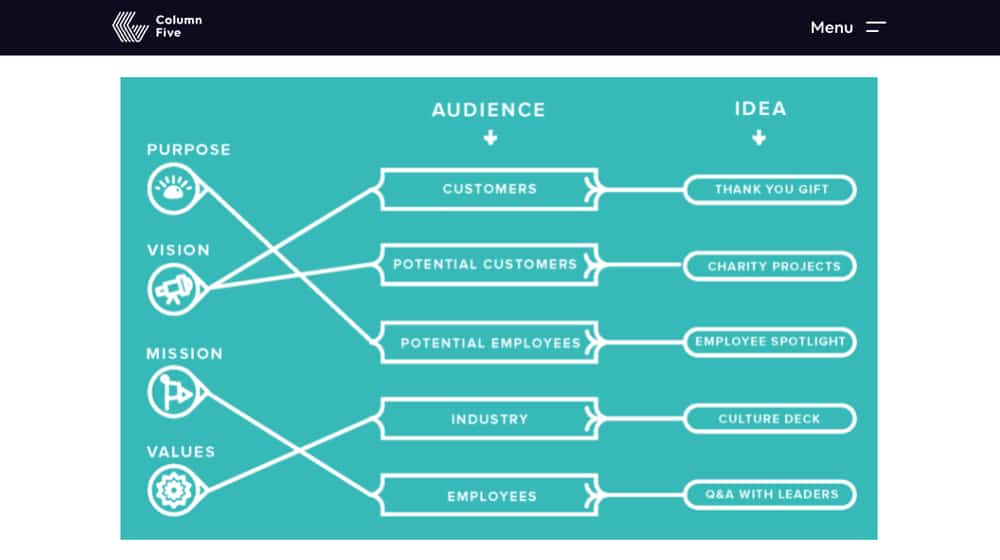A Beginner's Guide to Culture Marketing (With Tips and Strategies)

In America, there's a flippant joke about companies. Due to legislation that protects them and gives them additional rights, we often talk about how corporations are people.
Well, this isn't all that far off the mark, in a certain sense. Disregarding the politics and laws of the situation, companies have a lot of qualities shared by individuals. Each company has a unique set of goals, motivations, and stories. They're single entities made up of individuals working together. Those individuals have a collection of thoughts, views, and opinions, collectively known as the company culture.
Company culture is more than just a buzzword used in recruiting; it's a real thing, and it's crucial for your marketing strategy. That's why I've decided to talk about culture marketing today. Not many people talk about (there are "only" 234,000 results in a Google search for the phrase). Still, it's worth knowing to help you take your content marketing to the next level in ways that can improve your brand image and your bottom line.
Let's get started!
What is Culture Marketing?
First, let's talk about what culture marketing even is.
"Culture marketing is a form of content marketing that showcases your culture to help people get to know your brand. Whereas companies may focus general content marketing on your service, product, industry, or area of expertise, culture marketing focuses on who you are, what you care about, and how you interact with the world." – Column Five Media.
Culture marketing is a way of distilling your company culture and using that distillation as a basis for your marketing efforts.

There are many different ways to go about this. Two that I think are emblematic are:
- Zappos isn't a brand you might associate with a particular kind of culture. That's why they produced a "culture book" they distribute online. This culture book conveys the brand's ideals and perspectives and how their goals align with those ideals. You can see it here.
- When I mention Nike, you can probably picture their marketing already. The aggressive, athletic, active, sports-focused marketing permeates their entire brand. They have various offshoots, some focusing more on pro sports, others on home fitness, but they all share this overall value of effort and reward.
These two are representatives of two types of culture marketing: explicit and implicit.
1. Zappos is explicit. They've decided they want to use their company culture as a marketing tool, produce a piece of marketing copy, and market that copy.

Do the values in that book come across in the rest of their marketing? I don't know.
2. Nike, meanwhile, is implicit. They don't produce a "Nike Handbook of Cultural Perspectives" or whatever; they focus on their cultural values in every piece of marketing copy that they produce.

In my mind, this is the better way to go about it, though not every brand can have such a clearly defined and focused aesthetic.
Why is Culture Marketing Important?
If no one talks about culture marketing, how important can it be?
The truth is, it's hugely beneficial, but it's not necessary to succeed as a small business. It's one of those techniques that can take your brand from just another member of the pack to a stand-out example of success in your industry. It's a way of thinking about marketing beyond the metrics and split testing and into the conceptual values of the company.
Cultural marketing is helpful in several ways.
1. It helps engage customers and keep them loyal. People feel an inherent drive to associate with others like themselves; it's part of human tribal society.
If there are two brands in your hometown, with identical stores, identical layouts, identical product selections, equal in every way, how do you pick which one to visit? You don't care. Now, imagine that one of them is a big fan of your favorite sports team, while the other is a big fan of your team's main rival. You'll probably choose to visit the one that shares your values and promotes your favorite team.

The cynics among us might realize that neither brand cares and that it's all a ploy to take advantage of human tribal instincts. If you look a little deeper, you might realize that the company is made up of people as well, and those people are a tribe with values, and those values might match your own.
Suffice it to say; you can better attract and keep your audience on a deeper and more engaged level by espousing values shared amongst that audience. This strategy is effective whether the values are "likes the local sports team" or "believes everyone should help save the whales."
2. It can set you up for partnerships. As a brand, when you espouse specific values, you can attract the attention of organizations that also match those values. These partnerships can manifest in a few ways.
- Other businesses that share your values might offer to join a coalition of companies active in the space.
- Philanthropic organizations in that space might make a partnership with you for awareness and fundraising.
- Influencers who share those values might promote you, either on their initiative or by approaching you for a marketing deal.
- Larger organizations in that space might offer to fund and promote you in exchange for advertising.
It opens doors for you. Just remember that depending on the values and culture you're promoting, it might close doors as well. To use the sports team analogy again, fans of the rival team might refuse to visit your business.
3. It can affect the loyalty and activity of your employees. Company culture is essential externally, but it's also valuable internally. An employee working for an organization that doesn't share their values is probably just doing it for a paycheck.
Their heart isn't in it, and if a similar role opens up in a company they value more, they'll jump ship. Conversely, a company that shares its values will retain them longer, with stronger employee engagement.
How to Start Cultural Marketing
Alright, let's say I've convinced you that putting your culture into your marketing is a good idea. How do you do it?
Step 1: Review and Codify Your Culture
The first thing you need to do is perform a culture audit. You can't market your strong culture if you don't know what it is, after all.
This culture audit can be tricky if you've never focused on culture before, and it can be challenging if your company includes a wide variety of diverse perspectives. It's not realistic to push a "hoo-rah go America!" patriotic culture in a company that provides for employees all around the world. As another example, if you have several vegan or vegetarian employees, having "Barbeque Fridays" probably won't make those employees feel very appreciated.

When looking at your company culture, you'll want to look at it from three perspectives.
- Top-down. A top-down perspective is a culture set forth by past marketing, your CEO, executive team members and decision makers, and general directives.
- Bottom-up. Bottom-up culture is the culture of your ground-level employees. Ideally, it will be reflective of the top-down culture, but it may not be.
- Outside-in. An outside-in perspective is the culture of your company as seen by people outside of it. The authentic culture of your company may be very different than what the rest of the world sees, and it's a good idea to reconcile them. For example, your company's LinkedIn profile might not reflect what a day in the office actually looks like.
You'll want to answer some questions and figure out your company culture in a few specific ways.
1. Purpose. What is the overall goal of your company? Why do you exist? Surely you're more than just a vessel to shill a product and make the CEO money.
2. Vision. What is your goal for the future? What do you want to contribute to the world around you? How do you intend to make the world a better place?
3. Mission. What are the tangible, actual steps your company takes to make your vision and ideas a reality? Remember, actions speak louder than words.
4. Values. If you distilled the above down into a handful of proactive sentences, what would those sentences be?
Small and young companies can build this up out of whole cloth. Let's be honest; many companies start with a product, with the company built to support that product. Rarely do they start with values. They used to, a century or two ago, but those times are gone.

Older companies might have documents and quotations from former owners about the company's values, and it's essential to recognize that those may no longer be valid. Companies change over time, values shift. What might have been a progressive idea 100 years ago might be conservative now; do you stick with it, or are you still pushing a progressive viewpoint? It's an important question to answer.
Once you've figured out, in broad strokes, what your company culture is, you need to figure out what makes you unique about it. If every company in your industry shares the same values, using those values for marketing campaigns doesn't do anything for you. You need to find what sets you apart from the rest, and if you can't find something, create something.
Step 2: Brainstorm Cultural Marketing Ideas
Once you have your pillar values distilled down into sentences and keywords, it's time to figure out how to use that as a marketing initiative. Yes, it's a little cynical and businesslike to look at it from that perspective, but sometimes that's what it takes.

For example, let's say your business has a core cultural pillar of "We treat our employees as highly-valued individuals." You want to promote how you allow employees flexibility in their lifestyle, how you consider their safety to be paramount, and how you're generally a great place to work. You might:
- Send out care packages to your employees. The care package can include things like a spa day coupon (and the guaranteed day off to claim it), a nice treat like cookies or a hot chocolate mix, and other things your employees appreciate.
- Showcase videos of employees discussing how they feel valued in their workplace. Highlight a specific employee, showcase their accomplishments, feature them on your website, etc.
- Highlight steps you've taken to ensure workplace safety. These highlights could be industry safety awards, long-running certifications, a high number of "days without an incident," or even just showcasing how you've had everyone working from home during the pandemic.
If you're cynical, you might be thinking, "this is all a publicity stunt!" The truth is, you're somewhat correct. The difference, though, is that a cynical publicity stunt is faked for the attention, and cultural marketing requires you to make those efforts and highlight them rather than fake them.
Column Five has a list of examples of cultural marketing you can read, with some good ideas that many companies can mimic. It's not necessarily challenging to perform cultural marketing; you only need to be aware it's a thing you can do to put forth a strategy for the benefit of everyone.
Step 3: Map Marketing Channels for Specific Ideas
Now that you've come up with ideas, you need to figure out the best way to market them.

Build a map or a spreadsheet with associations between four things:
- The Value. The value is the core value you're espousing and, for example, valuing your employees.
- The Idea. The idea itself, which is essentially the care package that you're using as your marketing plan.
- The Audience. Your target audience is the demographic you're trying to attract with your marketing team. Valuing employees can target existing and potential customers or be part of brand marketing to attract applicants for open jobs.
- The Goal. What is the specific goal of this marketing effort? You might want to get more customers, engage existing customers, attract more job applicants, or something else.
One value will have numerous ideas, and one idea can have multiple audiences and goals. One audience can, of course, receive countless ideas, be subject to various values, and have various purposes. It can be quite a tricky cluster map, which is why you want to diagram it out.
Step 4: Take Action
Now it's time to take action. You have everything you need to produce culture marketing content, so now you need to do it. The only thing left is to take action to make your vision a reality, record and optimize content about it, and use that content in marketing. Whether that means videos you post to social media, profiles you write for your website, blog posts you use to deep dive into your workplace culture, or some other channel, it is up to you. Ideally, you'll want to do all of the above.
The key is to be genuine. If you're not genuinely taking action or taking limited activity for a publicity stunt but abusing it in other ways, you'll be found out and called out. Cultural marketing is a great option to boost your brand ahead of the rest in your niche if you can do that.










January 26, 2022
This is the first time I've encountered the concept of culture marketing! It's certainly interesting and seems like a good idea to try out.
January 28, 2022
Hey Ryan!
It's an interesting technique! Admittedly it's something we should be putting more effort into as well.
People love seeing interactions with your brand and the faces behind your company, especially for digital businesses.